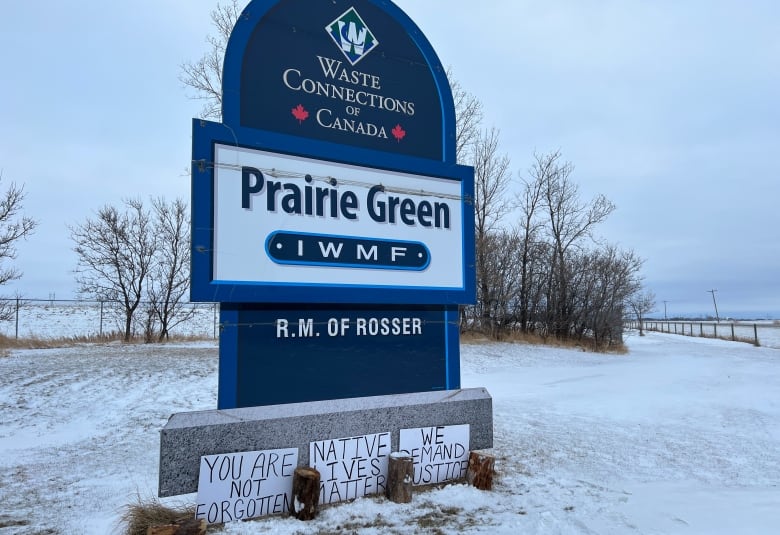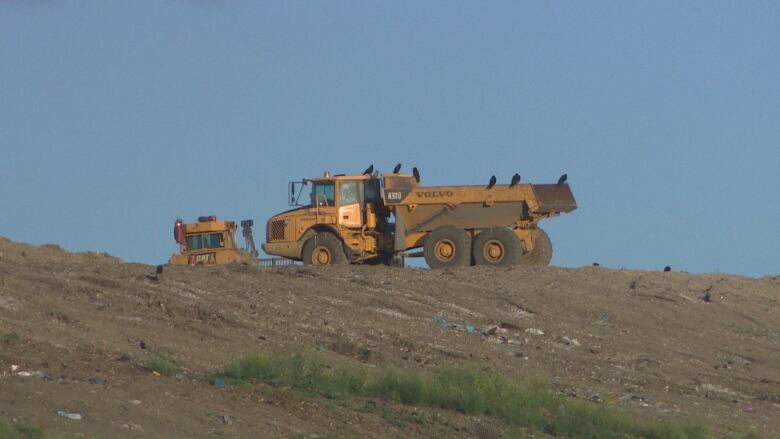How do you safely search a landfill? And other questions about possible search for remains of 2 women
CBC answers some FAQs as advocates call for action, governments cite safety risks of search

Emotions are running high with the leak of a feasibility study outlining ways to approach the search of a Winnipeg area landfill for the remains of two Indigenous women killed last year.
Police believe the remains ofMorgan Harris and Marcedes Myran two of four victims of an alleged serial killer weredeposited last year at Prairie Green landfillnorthwest of Winnipeg.
First Nations leaders, advocates and loved ones feel the study supports plausible paths forward to search Prairie Green.
Manitoba's premier has been reluctant to financially or otherwise support the search, pointing to potential safety hazards highlighted in the report.
There are also considerable financial costs and timelines associated with searching outlined in the report, contrasted againstbroader social impacts to loved ones and community members tied with not searching.
CBC News has compiled answers to a series of commonquestions about the report below.
How did we get here?
In December, Winnipeg policesuggested the scope and scale of a search wasn't feasible.
Between December 2022 and March of this year, a consortium of First Nations-led groups asked for and obtained federal government funding for a search feasibility study of Prairie Green.

Oversight and technical subcommittees were tasked with answering keyquestions: is such a searchfeasible, and if so, how could it be done, what would it cost and how long might it take?
The report was leaked in full late last month.
How do you search?
On the high end, a search could entail going through about 62,000 tonnes of debris.
The report reviews a variety of possibilities, including the use of cadaver dogs specifically trained to sniff out gasses associated with decomposing remains.
In a scenario where dogs are used as the primary search tool, rows of debris would be excavated andlined up for them to go through.
But relying on dogs and their handlers comes with limitations given the size of area and vast volume of odorous materials, the report states.
If using dogs and handlers as the primary search method, you'd need eight to 12 teams working in consistent rotation. That could be "quite slow" and "would deplete almost the entire group of North American cadaver dog search teams."
The dogs would also be at "high risk for injury" going through hazardous materials, and it's possible remains could be missed.
That's why the team ultimately recommends a custom-built conveyor belt as the best primary means of sifting through debris, possibly complemented by the use of dog teams.

It couldbe staffed by one of two teams of 10technicianstrained in search methods andsafe work practices who could look out for possible remains and personal effects.
They'd need access topersonal protective equipment, including hazmat gear, respirators, puncture-resistant gloves and more.
Every piece of bone or soft tissue they encounter would need to be collected and assessed by asite forensic anthropologist. The report recommends Winnipeg police should then be looped in to do the final confirmatory work to decide if the material is indeed human remains.
Where would they search material?
Once material is excavated, it could be taken to aseries of temporary buildings, namely trailers and temporary structures, for sorting through.
Or,the conveyer belt system and offices could be nested within a purpose-built, 2,100-square-metre "super structure," the report said.
Such a building would need to be equipped with additional screening systemsand offices for elders, project managers, student support workers and a forensic anthropologist.
Thebuilding would need washrooms, change rooms, a decontamination area, a lunch room, tool storage and a climate-controlled space where items could be kept while awaiting review by the anthropologist.
The conveyor belt approach has been field tested both in the aftermath of the 911 attacks in New York City in 2001, and the 2002-03 search of convicted serial killer Robert Picton's B.C. farm. Neither are perfect analogies for the kind of search proposed at Prairie Green, the report acknowledges.
What are the safety concerns?
Manitoba Premier Heather Stefanson last week cited safety concerns associated with staff searching the landfill as to why the province wouldn't be financially supporting the effort.
WATCH | Premier says decision not to fund landfill search for remains was about safety:
So what does the report say?
One section weighs risks and hazards associated with excavating and searching debris from a key section of the dumpidentified as possibly containing the remains.
Exposure to toxic gasses like methane, carbon dioxide and hydrogen sulfide byproducts of decomposing materials common to landfills are all possible and carry risks such assuffocation, the report states.
Headaches, irritation to skin, eyes, throat and lungs, memory loss, disorientation, slower reaction times and permanent nerve damage are listed as possible side effects of exposure to hydrogen sulfide in particular.

There's also a known 712-tonne deposit of bags of asbestos on a slope at the keysite. The report suggests it is possible both women are located between that deposit and a layer of soil.
Once disturbed, breathing in asbestos can cause pneumonia, heart disease and mesothelioma, which is a form of cancer. Risks are tied to length of time and volume of substance someone is exposed to, and diseases can take years to pop up, the report said.
There's also the possibility of coming across biohazards from dead animals or human remains.
Then there are risks inthe physical search environment.
Excavating a slope of the landfill could lead to a landslide, though the focal search site doesn't have terribly steep slopes, according to the report, and stability of excavation could be managed through monitoring by an engineering firm.
The report suggests many of the above safetyrisks could partly be mitigated through establishing robust safety and building protocols, training, emergency response planning and use of personal protective gear such as masks.
What would it cost?
Between $84 million and $184 million.
That all hinges on the scope of the search.

It's tough to pin down how many tests would be needed, but the report recommends allocating an additional $2.5 million for 1,000 possible tests.
How long could it take?
Weather, volume of debris, size of the search area, resourcesand the inherently challenging scale of a search make timelines a bit of a moving target.
The report authors suggest it could take anywhere from 12 to 36 months.
The high end of that estimate is tied to the possibility of a site-wide search, with six months of preparation and planning at the front endand about 2years of searching.
Shorter timelines are also possible; searching the entire landfill might not be necessary. That's if a hunch on where the load suspected to be carrying both women is accurate.
On June 19, 2022, investigators came to the belief Myran and Harris's remains arrived at Prairie Green between then and about a month earlier in the same garbage truck. They informed Prairie Green the following day, which paused any further loads from being dumped in the specific section the landfill operator suspects the load was dropped off.
There was about five weeks of trash deposited in that section before the decision to pause.
Technicians on the conveyer belts would sift through that debris in 12-hour shifts, rotating through different roles, and put in 62 hours of searching weekly.
Odds of success?
The report authors suggest finding Myran and Harris is possible.
They also stress there are "no guarantees for the recovery of remains" and how coming away empty-handed could have adverse impacts.
Searching a landfill for human remains can "drastically affect" the mental health of those involved. The knowledge that Myran and Harris are victims of a homicide can add a greater toll to searchers' well-being, the report states.
The concerns warrant supports for people involved in all levels of searching, family members of Myran and Harris, and for the broader Indigenous community, the report says.
That could include facilitating traditional practices for elders and loved ones complete with an all-weather location on-site to hold ceremonies, fires, providingmedicines and spiritual assistance.
"Until Marcedes and Morgan are properly returned home, these women, their families and all our communities endure a sacrilege," the report states. "To this end, the entirety of the [Prairie Green] project is a ceremony, and the entire project must begin and end with ceremony."
Social impacts of not searching
The report also explores the social impacts "that cannot be quantified financially" of deciding against searching.
Passing on a search could "send a message that disposing of victims in dumpsters is a good method for perpetrators and one that comes with impunity."
It could also have "lasting repercussions" on loved ones of Myran and Harris and Indigenous communities across Canada. They deserve the same chance at "closure and justice" as all other Canadians, the report concludes.
WATCH | Supporters outline why they're blocking Brady Road landfill:
Beyond the search
The above considerations are why the report authors included six recommendations at the tail end that extend beyond searching.
They say there's a need for more social and culturally appropriate supports for Indigenous people, such as greater access to addictions programs, affordable housing and mental health supports, as well as more funding for homeless shelters.
They want GPS tracking systems to be mandatory for all garbage truck companies operating in Manitoba, and rear-facing cameras mounted to the back of each so drivers can see what's in their load before compressing it.
The report also suggests more widespread tracking systems be implemented at dumps and for the government to support smaller municipalities in this effort.














_(720p).jpg)


 OFFICIAL HD MUSIC VIDEO.jpg)
.jpg)



























































































